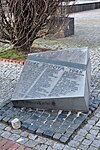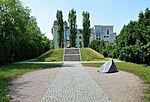Kniefall von Warschau
1970 in Germany1970 in Poland1970 in international relationsAll accuracy disputesGermany–Poland relations ... and 4 more
History of WarsawHolocaust commemorationKneelingWilly Brandt

The term Kniefall von Warschau, also referred to as Warschauer Kniefall (both German for "Warsaw genuflection"), refers to West German Chancellor Willy Brandt kneeling and giving a moment of silence during a visit to a Warsaw Ghetto Uprising memorial in 1970.
Excerpt from the Wikipedia article Kniefall von Warschau (License: CC BY-SA 3.0, Authors, Images).Kniefall von Warschau
Warsaw Śródmieście (Warsaw)
Geographical coordinates (GPS) Address Nearby Places Show on map
Geographical coordinates (GPS)
| Latitude | Longitude |
|---|---|
| N 52.249444444444 ° | E 20.993888888889 ° |
Address
Warsaw, Śródmieście (Warsaw)
Masovian Voivodeship, Poland
Open on Google Maps











